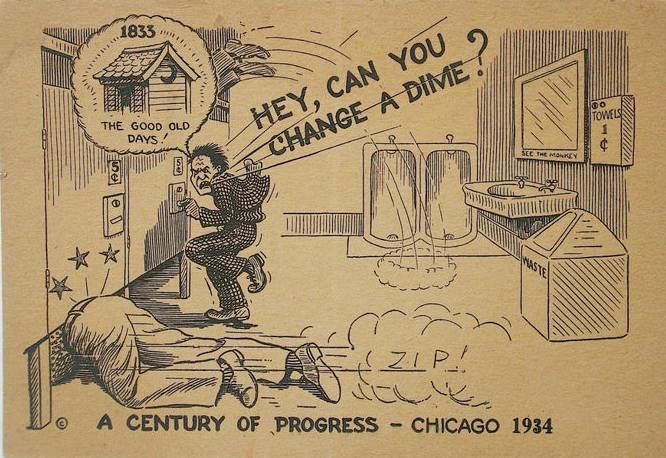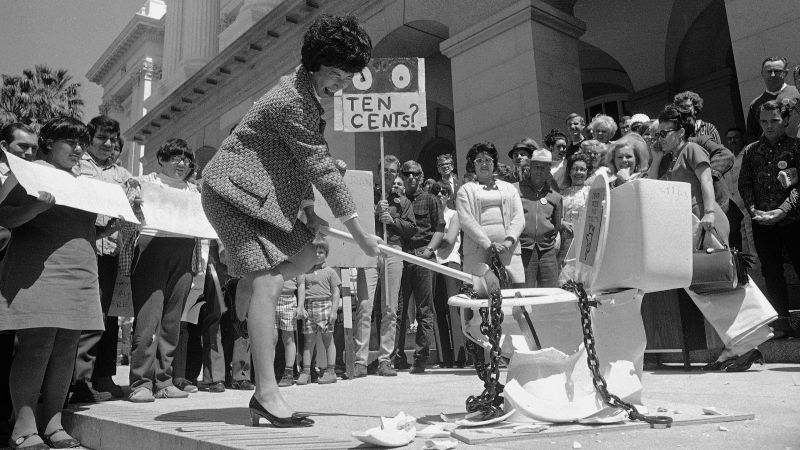Why In America, It’s Typically Free to Go Pee
The restrooms at malls, airports, or other major public places can be a risky experience. It’s a simple numbers game — when you have that many people using a common facility, it’s likely something is going to go awry. Combine that with the fact that the proper way to use a restroom is, well, something you wouldn’t do anywhere else, and the odds of a gross outcome are pretty high.
For a long time, we had a partial solution — the pay toilet. If you wanted to use a stall at a restaurant, gas station, stadium, etc., you could — but it would cost you a dime. This served two purposes. First, the money itself could be used for the maintenance of the facilities, much like money collected by toll booths (in theory) goes toward bridge and road upkeep. And second, those who sold toilet locks advertised them as a great way to reduce vandalism and similar ills. Sure, there were workarounds, like that depicted in a 1930s postcard seen below. But in general, pay toilets seemed like a good way to make the public restroom work.

And yet, pay toilets are virtually unheard of in modern America. The main reason why? Four teenagers needed something to talk about.
The leading faction against pay toilets was something called CEPTIA — the Committee to End Pay Toilets in America. The impetus, per Pacific Standard, was a trip the otherwise unimportant Gessel family had taken in 1968. The two sons, Ira and Michael, were fascinated by the pay toilets they encountered during a stop on the Pennsylvania Turnpike. While there’s no reason to believe that the 10-cent barrier to entry denied them access to relieve themselves, the Gessel brothers had found the situation off-putting. They discussed the situation with two of their friends, Steve Froikin and Natalie Precker, and the four high schoolers agreed: when you’ve got to go, you’ve got to go — and having exact change (or any money at all) shouldn’t be a pre-requisite. The right to go was, they deemed, a human right.
That’s a little silly — to give an absurd example, you don’t have a right to enter my house to use my toilet, no matter how big of an emergency it is. Similarly, it’s hard to make the civil rights case against a pay toilet. So the quartet’s argument was a struggle from the start, but it got even more complicated: they weren’t taking it all that seriously in the first place. When the four went off to college in 1969, their collective efforts to ban the pay toilet seemed destined to go down the drain. After all, in the pre-Internet era, they were likely to lose contact.
But the shared scourge of ten-cent toilets kept them together — they remained in touch to discuss ways to fight for the right to do one’s business for free. In the summer of 1970, the four officially formed CEPTIA and held their first public meeting at a library in Dayton, Ohio. (Whether the library had pay toilets at the time has gone unreported.) The quartet brought two dozen friends with them. A movement had begun.
Their timing couldn’t have been much better — a summer earlier, this happened:

That’s a California Assemblywoman named March Fong. The picture (via), taken in April of 1969, shows her taking a sledgehammer to a toilet which she positioned in front of the California statehouse. The “ten cents?” sign in the background should give you a clue about what Fong was protesting.The protest went unheeded — the Assembly didn’t care to act. But Fong’s message reached the future founders of CEPTIA. Fong pointed out that while stalls had the pay locks installed, urinals rarely did, and therefore, pay toilets were (unintentionally, one hopes) discriminatory.
CEPTIA incorporated these arguments into their own, doubling down on the idea that pay toilets violated their rights somehow. The organization gained more and more members and politicians began to take notice — and really, what kind of politician wants to be in favor of a pee fee? And in 1973, CEPTIA had their greatest victory — they convinced the city of Chicago to outlaw pay toilets in all municipal buildings, with O’Hare airport being the most important among them.
Despite efforts by lock makers, restaurant owners, and others who benefited from the required dimes, other municipalities and states came to similar decisions. And quickly, too: by 1976, CEPTIA convinced a dozen states to ban pay toilets, and setting forth massive cultural change in the sector.
CEPTIA disbanded that year, per the New York Times. (This was most likely because its founders wanted to do something other than fight against pay toilets.) But they had set in motion an unstoppable force against toilet-gating. Pacific Standard summarizes the success: “by 1970, America had over 50,000 pay toilets. By 1980, there were almost none.”
Bonus fact: If you go to Times Square, Manhattan, on New Year’s Eve to see the ball drop, expect cold weather, huge crowds, and no toilets. The event typically gets around a million attendees, but most are holding it in; as the Times Square Alliances explains on their event FAQ, “there are no portable restrooms in Times Square during the celebration. ”
From the Archives: Atlanta’s Fight to Separate Elevators and Restrooms: Two things which shouldn’t go together, but often do.
